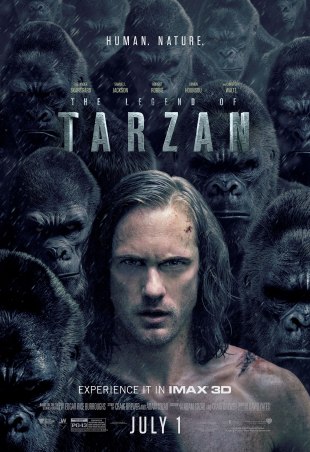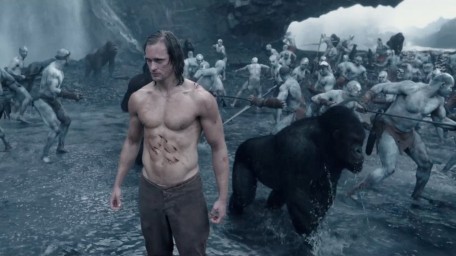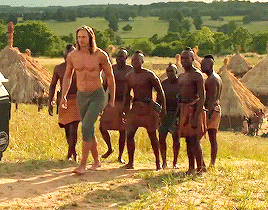The Legend of Tarzan (2016); And Safety in Grossly Watered Down History
 I don’t go to the movies too often anymore. I feel like a bad critic or a failure among film theorists because I realize that I’m not exercising my critical mind by keeping up with what studios think the masses like, and what the masses actually like. There’s a multitude of reasons that I don’t hang out at the theater like I used to years ago. Mostly, I refuse to pay the jacked up prices that inner city movie theaters get away with charging these days. Another large reason is that most films I’ve seen in theaters tend to air on the side of sub par. The gems that I keep unearthing now is through streaming television.
I don’t go to the movies too often anymore. I feel like a bad critic or a failure among film theorists because I realize that I’m not exercising my critical mind by keeping up with what studios think the masses like, and what the masses actually like. There’s a multitude of reasons that I don’t hang out at the theater like I used to years ago. Mostly, I refuse to pay the jacked up prices that inner city movie theaters get away with charging these days. Another large reason is that most films I’ve seen in theaters tend to air on the side of sub par. The gems that I keep unearthing now is through streaming television.
Lo and behold, I got graced with the opportunity to see an early screening of The Legend of Tarzan. This moment of film going cemented itself as the exact reason why I don’t frequent the theaters anymore. Seeing it for free arguably made the film much more tolerable. But, make no mistakes about it, The Legend of Tarzan is barely adequate. It’s the “just right” of Goldie Locks’ testing throughout the 3 Little Bear’s home. I give it kudos for revisiting taxing subject matters of the past, but it never goes too far into controversy.
The Legend of Tarzan is just lukewarm enough to please enough movie goers that it’ll make its millions before vanishing from public consciousness a few years from now. It’s a film that lacks any flavoring. It’s bland enough for those who don’t like salt in their dishes, and peppered just enough to convince others that it has a distinctly different taste.
The story of Tarzan isn’t a relevant tale that stands the test of time. Long ago in the African forests legend had it that a child was raised by apes. That child, shipwrecked and abandoned on an island, grew to become Tarzan (Alexander Skarsgard), a half-man, half-ape being that swings through trees, talks to animals, and married a Western woman named Jane. How director David Yates tells the story, Tarzan’s relevance to our current time is his existence during an age of colonialism, rampant racism, and slavery throughout Africa thanks to the European countries that surrounded it.

In this telling of Tarzan’s legend, he has escaped the forests and lives with Jane (Margot Robbie) in English civilization. That is until a worried ex-Civil War solider, George Washington Williams (Samuel L. Jackson), convinces Tarzan to return to Africa after he smells something amiss about how the bankrupt King Leopold of Belgium is still able to work on building a railroad system.
Tarzan’s place among the trees serves as a backdrop for him to return to Africa and free the people he’s known and the animals he’s loved from white oppression and greed. For this, I respect The Legend of Tarzan, deeply. My knowledge of Tarzan comes from the Disney version where Africa is filled with singing animals and the people of the land with melanin don’t exist. The Legend of Tarzan gives representation to various tribes in the Congo and other parts of Africa. It also touches on the injustices experienced by minorities due to white commands as George Williams even recalls his own recoil and regret in his role of displacing Native Americans after the war.
The Legend of Tarzan does a menial job scratching the surface of the problem of colonialism and white supremacy, but it’s only superficial. There is no deeper digging or kicking up dust here. Instead, The Legend of Tarzan plays it safe keeping the African characters as background props limiting only a handful of Black men with speaking parts and minuscule back stories that aren’t explored if they don’t have the film’s white counterparts as the forefront. There is a diminutive amount of individuality. Black bodies act as a mass, a dark form to see as “other” and not people with stories, loves, hopes, and fears. Black women don’t speak unless it’s all at once through song. Aside from a few scenes with Djimon Hounsou as a tribal Chief, only Jackson as George Williams gets major screen time as a bumbling, sassy sidekick who I repeatedly expected to say “I’m getting too old for this shit.”

Jackson is the comedic relief, but leaves much to be desired in his role and character. That’s not his fault, however. Writers Adam Cozad and Craig Brewer were much more focused on developing Tarzan’s relationship with Jane which musters up to nothing more than physical affection. We get the opportunity to see George open up and explore his feelings in the few moments of focus he receives. The same can’t be said for Tarzan and Jane, whom we are constantly reminded are the breadwinners of the film. They don’t open up to one another or goof around like a real couple would. We continuously only hear about how much they love one another.
The Legend of Tarzan chooses to avoid going too deep into the politics and brutality of King Leopold or his advisory, Leon Rum (Christoph Waltz), and their exploitation of human bodies in the Congo. Instead, their heinous legacy gets watered down to slavery for the promise of diamonds. Nowhere in the film does it allude to the reality that Leopold was a mass murder who committed genocide for mere rubber, yet still managed to end up broke and bankrupt. Nowhere does the film mention that Leopold openly abused and mutilated the Congo residents that he forced labor upon. The nameless individuals whose lives were lost to Leopold’s greed is once again glanced over and ignored shifting the focus to a stock evil European bad guy and a bland love story between two unimpressive people.

The Legend of Tarzan attempts to go there without actually going there which makes for a disappointing tale. Meanwhile, the CGI is so prominent and weak that it actually detracts from the film’s aesthetic potential. Action scenes are rubbery and flaccid sucking out any tension or fear for character’s lives with it. I never worried about Tarzan’s safety because when ever he’d jump into fake trees or into a fake waterfall his body adopted an elastic sheen that I knew would protect him. There’s no magic to Tarzan which is all the more reason to avoid watching this film and wasting your time. Honestly, The Legend of Tarzan would have been better off as a porn film where Alex Skarsgard’s physicality could get showed off properly while all the sexual tension built between him and doe-eyed Jane could work out with better ease.

AVOID IT. Just read up on the real story of King Leopold’s exploits for yourself.

